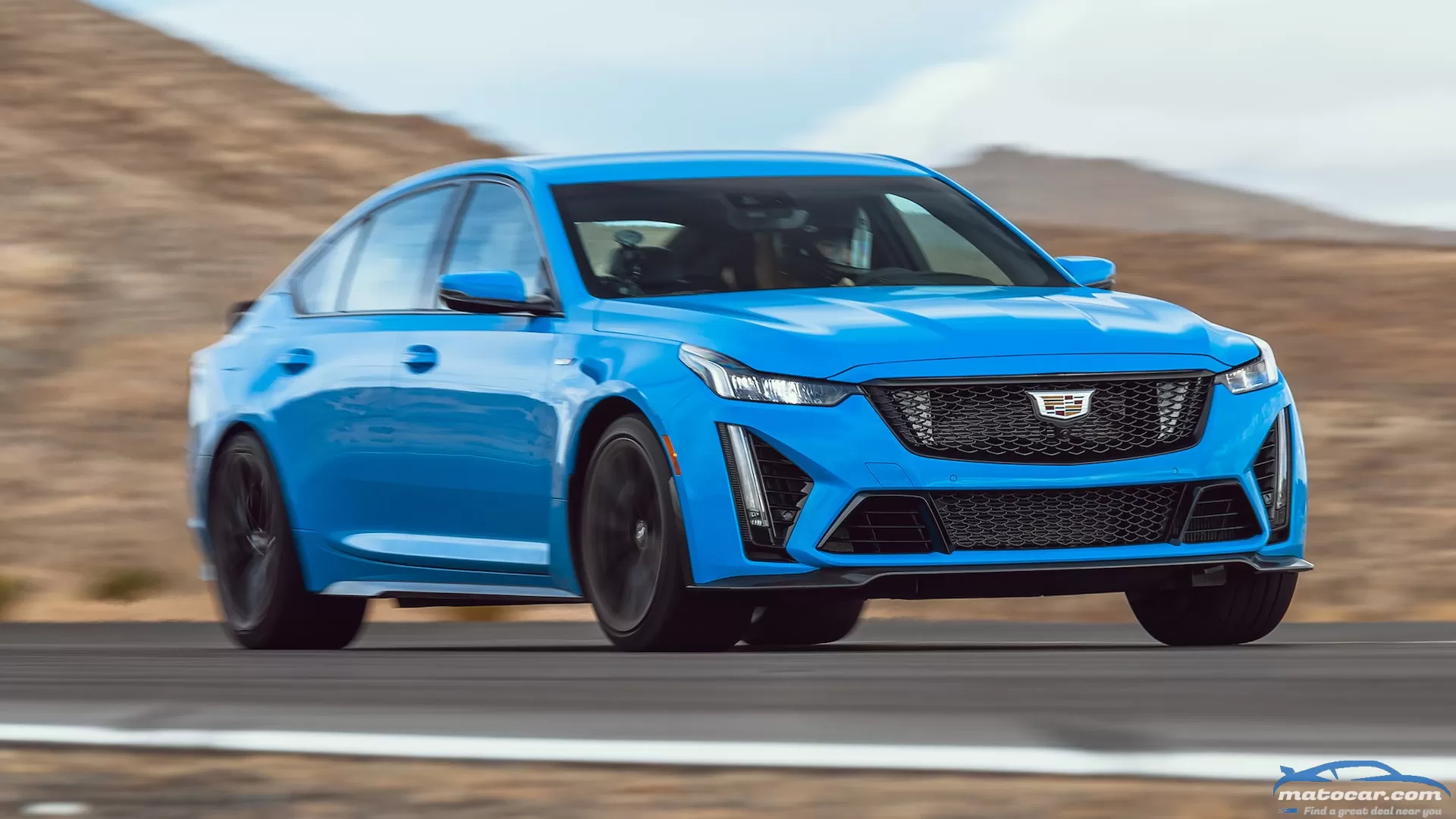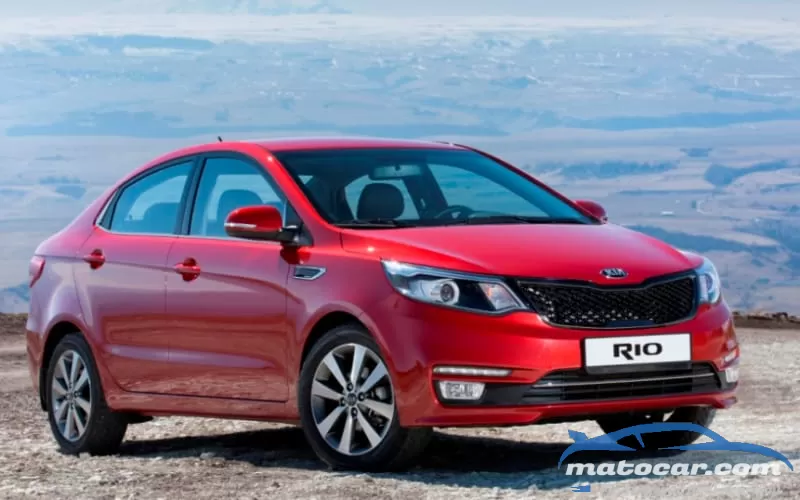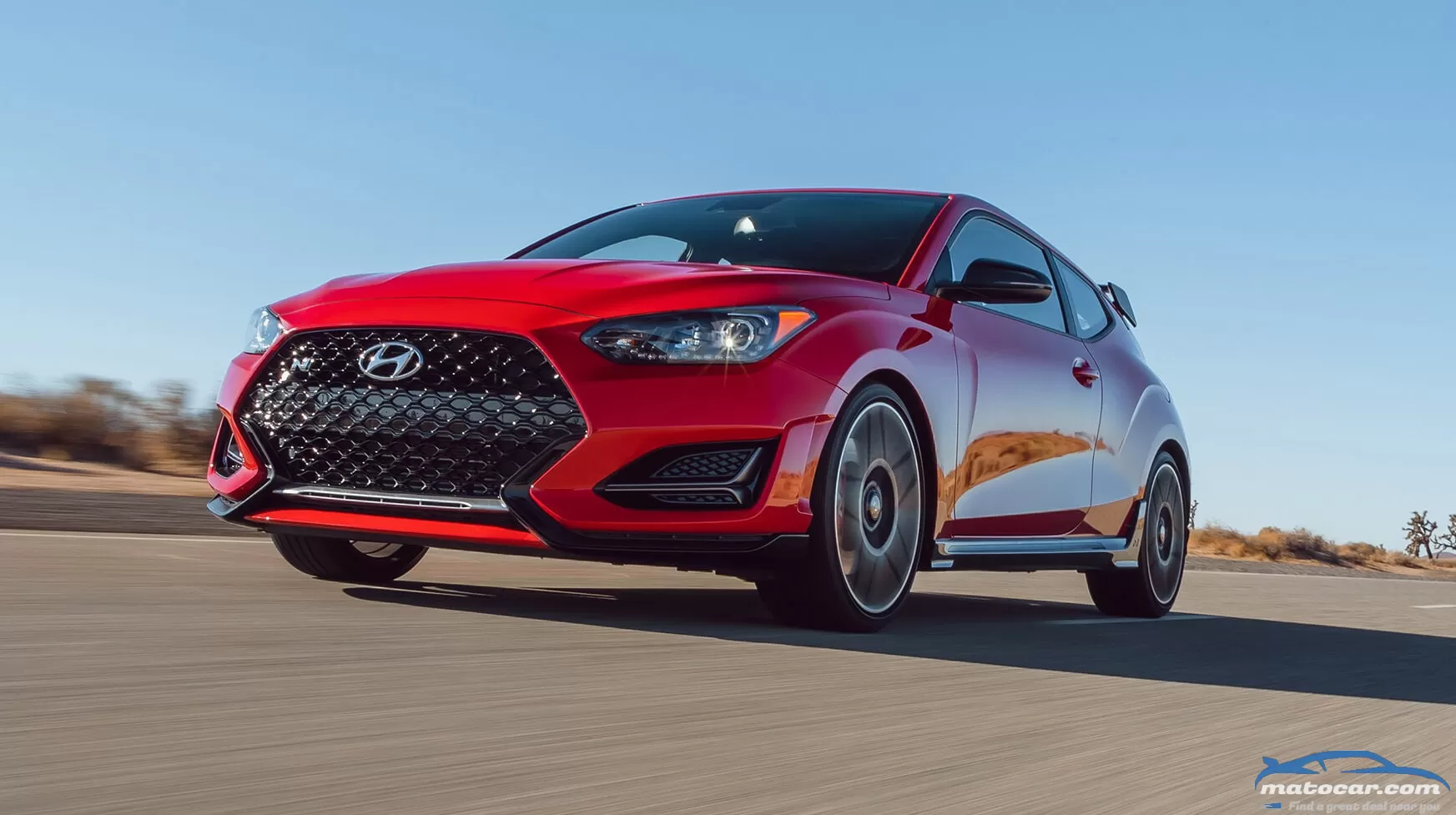2022 Cadillac CT5-V Blackwing First Test: Prepare to Take Flight

Cadillac's story in the two decades since the year 2000 has been one of chasing dreams. It went on a search for Art and Science. It traveled east to New York to find brand cachet and score modeling gigs. Like every carmaker, it pivoted wildly to crossovers and SUVs. Then along came EVs and the pledge that every Cadillac would soon be all-electric, all the time.
Then there was V, the attempt to out-German the Germans at sport sedans. Like many of Cadillac's efforts in the past 20 years, it didn't quite pan out. But man, did the company ever get close, and the 2022 Cadillac CT5-V Blackwing is the proverbial going-out-with-a-bang car that should reverberate as one of the greatest American sport sedans of all time 20 years from now.
The powertrain numbers are the pinnacle of Cadillac's gas-only power and performance: 668 hp and 659 lb-ft of torque from a 6.2-liter supercharged, direct-injected V-8. The engine itself is one of the last of the venerable LTs from GM's murderer's row of V-8s—the LT4. You get your choice of transmissions to pair with this aluminum-cast monster: an available 10-speed automatic or the standard Tremec six-speed manual.
How Well Does the CT5-V Perform?
For our instrumented test runs, we scored a manual-equipped version of the 2022 Cadillac CT5-V Blackwing. It also came with one significant performance upgrade, Cadillac's optional carbon-ceramic front and rear brake package ($9,000). Though our test team experienced some issues launching the car from a stop, the CT5-V (eventually) performed about as expected.
In fact, our number from 0-60 mph mirrored what Cadillac called out in its own estimates, a 3.6-second run. But it didn't exactly come easy. We found it incredibly tricky to get the CT5-V to hook up, despite following Cadillac's extensive launch instructions, including bleeding the tires down to 35 psi, which helped.
Our most experienced tester, road test editor Chris Walton, also had his hands full with getting the CT5-V to launch correctly and channeling the car's prodigious power to the pavement. It ultimately thundered its way to a best quarter-mile time of 11.5 seconds at 127.5 mph.
"I, too, struggled with the launch on this car," Walton said. "It's one of those 'you can't go to wide-open throttle until the very top of first gear or you roast the rear tires.' I tried automatic launch control first, then started tweaking the launch rpm and tire-slip knobs. After failures and some successes, I found one that worked on our testing surface: 4,000 rpm with 10 percent slip, which goes against logic, but it worked."
The brakes were also a bone of contention with the test team. We recorded 102 feet to stop from 60 mph—a more than respectable number, especially considering the CT5-V Blackwing's 4,067-pound curb weight—but Walton wasn't exactly enamored with what he found when he pressed the slow pedal. "The brakes are OK," he said. "The pedal feels unnecessarily firm, making it difficult to modulate on the release into the skidpad." That said, the team reported that the carbon units held up well after repeated whoa downs from triple-digit speeds.
Dynamic Numbers Are Dynamic
We also had some trouble getting things totally sorted on the skidpad, but the 2022 Cadillac CT5-V Blackwing still put up some super numbers in the lateral-g and figure-eight departments, helped in part by a set of Michelin Pilot Sport 4S tires. Its 1.04-g average number is up there with the best sedans we've tested in recent years, and it matches that of the 2022 BMW M5 CS (interestingly, its CT4-V Blackwing stablemate performed a smidge better at 1.05 g).
Out on our MotorTrend figure eight, the CT5-V Blackwing posted a 23.4-second lap at 0.89 g (average), with the M5 edging it at 23.2 seconds at 0.92 g. No, it didn't quite out-German the M5 dynamically, but for a front-engine, rear-drive sedan with a manual transmission (the M5 is all-wheel drive with an eight-speed automatic), the Cadillac is right there with it. That's duly impressive for a car that is in essence in its first and last generation. Yes, it's an evolution of the CTS-V, but the 2022 Cadillac CT5-V Blackwing is its own car, a Blackwing that can really fly.
SPECIFICATIONS 2022 Cadillac CT5 V Blackwing BASE PRICE $84,990 PRICE AS TESTED $112,545 VEHICLE LAYOUT Front-engine, RWD, 5-pass, 4-door sedan ENGINE 6.2L Supercharged direct-injected OHV 16-valve 90-degree V-8 POWER (SAE NET) 668 hp @ 6,500 rpm TORQUE (SAE NET) 659 lb-ft @ 3,600 rpm TRANSMISSION 6-speed manual CURB WEIGHT (F/R DIST) 4,067 lb (54/46%) WHEELBASE 116.0 in LENGTH x WIDTH x HEIGHT 194.9 x 74.1 x 56.5 in 0-60 MPH 3.6 sec QUARTER MILE 11.5 sec @ 127.5 mph BRAKING, 60-0 MPH 102 ft LATERAL ACCELERATION 1.04 g (avg) MT FIGURE EIGHT 23.4 sec @ 0.89 g (avg) EPA CITY/HWY/COMB FUEL ECON 13/21/15 mpg ON SALE Now Show AllLooks good! More details?
You may also like
The Russian incursion into Ukraine this week has thrown European and global markets into a frenzy, as automakers work to determine how big an impact the war, and any economic sanctions against aggressor Russia, will have on supply lines, production, and workforces who could now be in direct danger. Europe's home automakers will be hit the hardest, as supply lines from Ukraine and Russia freeze up while bombs get dropped. However, Hyundai and Kia's massive manufacturing presence in Russia now presents a huge headache for the Korean group, as well.Multiple global automakers have reportedly halted shipments of local dealer orders to Russian partners, effective February 24, the date of the Russian invasion, according to letters apparently sent from the automakers and viewed by the Russian-language business paper Vedomosti. Russian dealers for Audi and Chevrolet reportedly received notices, and Vedomosti claims VW and Skoda are prepping notices of their own. Porsche and Land Rover's Tata Group had also halted shipments starting the date of the Russian invasion. If this is all true, and it likely is, it's unclear exactly what conditions forced the shut down—but it probably isn't going to be easy getting your car through Russian customs right now.The report says Audi will inform its partners on its plans to resume shipments down the road. Any inventory from automakers that's already passed through Russian customs will still be delivered. The quick move to halt shipments to Russia on the part of most automakers is likely precautionary and temporary, and more to do with establishing new logistics options adapted to an environment now at war, and in the environment of new global sanctions against Russia. Companies obviously face public pressure to not appear too cozy with a current aggressor, so the shipment freeze is likely an indefinite delay until everybody calms down.If you're wondering if the U.S. government and its allies' sanctions against Russia will further exacerbate the ongoing semiconductor shortage, the answer is of course. While no semiconductors or raw materials used to make them will be flowing into Russia, much of the raw materials come from Ukraine, which probably won't be exporting them for a while.Hyundai + Kia In RussiaThe Korean automotive sector is hugely reliant on Ukrainian-provided rare gases like neon, krypton, xenon, and more, everything from EV battery cells to superconductors are now on an even tighter supply line, and prices will go up. And speaking of gas, the kind you use to fill up your car at the pump likely will get more expensive in the coming weeks as energy prices rise globally, especially if European nations abstain from Russian fuels in response to its attack on Ukraine.Hyundai Group, which Kia also operates through, first established itself with a factory in St. Petersburg, Russia, in 2010 and recently purchased a former General Motors facility to renovate for Hyundai Tucson, Palisade, and Kia Sportage production for export to North America and the rest of Europe this year. The automakers combined currently produce more than 230,000 cars annually in Russia.That's just what they build there—Hyundai Group sold 373,132 vehicles in the Russian market in 2021, holding the largest market share; Hyundai accounts for 10.3 percent and Kia 12.3 percent of Russia's total vehicle market share.The outbreak of war and the onslaught of economic and financial sanctions against Russia now put all of Hyundai and Kia global business in jeopardy and will severely damage the national Korean economy, as well. The Korea Times says "Korean conglomerates" sold $2.5 billion worth of cars to Russia in 2021, plus an additional $1.45 billion worth of car parts and components.Cars and their parts previously accounted for 44 percent of Korea's annual export volume to Russia, which will likely be severely hindered by American and European sanctions looking to cut trade and handicap Russia's economy.Kia takes home four prizes at the annual Russian Car of the Year awardsHyundai + Kia in UkraineHyundai also operates a local sales office in Kyiv, Ukraine, and Kia produces the Rio sedan and hatchback at the ZAZ factory in Zaporozhye, Ukraine. On January 28, 2022, the Korean Ministry of Foreign Affairs announced a state of emergency in the region and established plans to evacuate Korean nationals out of Ukraine, the Korea Times reports.Hankook Tires, another Korean company, evacuated its sales office in the country. An official from Hyundai offered that the company has "been closely monitoring the situation as the Russian-Ukraine crisis is expected to bring about an economic slump and weak ruble," in a statement to the Korea Herald.The war in Ukraine could also severely impact global EV battery cell production, as the nation is the world's third-largest producer of nickel and aluminum, two highly valuable resources necessary in battery and EV components. Additionally, Ukraine produces almost 70 percent of the world's neon gas needed for components like chips, which are already suffering a shortage that has driven the average new vehicle transaction price in the U.S. to unbelievable new heights. It will likely only grow higher this year.Ukraine is also a critical global supplier of rare gases used in all sorts of high-tech equipment and components, and the war will severely hinder those supplies and likely cause prices to rise. This, too, will have a specific impact on the Korean economy, as the nation imports 30.7 percent of its krypton, 23 percent of its neon, and 17.8 percent of its xenon rare gases for component production from Ukraine, according to the Korea Herald. South Korean-based automaker SsangYong also imports raw materials like aluminum from the region.The Korean Automotive Manufacturer's Association fears up to 29 percent of its group sales could drop this year, anticipating a similar impact to when it witnessed a 62 percent drop in auto exports after the Russian incursion in Crimea in 2014, which also brought about international sanctions against Russia.New Sanctions on RussiaIn response to Russia's invasion of Ukraine, the U.S. Treasury Department announced it would immediately target the core infrastructure of Russian financial and some economic institutions. Sanctions target banks such as the state-backed Sberbank, VTB Bank, Otkritie, Sovcombank and Novikombank. The move is meant to ban any trading with U.S. institutions and freeze any U.S. assets held by the companies and their executives.This first wave of sanctions from the U.S. and its allies, announced on February 24, did not specifically target Russia's auto sector or any enterprises directly involved. However, some major economic enterprises related to autos were targeted, including Russia's Sovcomflot shipping company and Russian Railways, as well as much of the Russian energy sector.Russia is currently the third-largest supplier of nickel in the world and provides 40 percent of global palladium resources used for manufacturing catalytic converters, according to NBC. In return, Russia also relies on foreign supply lines for as much as 25 percent of its home automotive production, which could be heavily sequestered by new sanctions. The Russian Gaz Group has already announced that it will have to halt production as sanctions are levied against Russia.Analyst Sam Abuelsamid from Guidehouse Insights told NBC the big question regarding sanctions comes down to China: "If we put heavy sanctions on Russia, they might respond and cut us off from many of the things we need," including circuit boards and other raw materials, such as the lithium needed for electric vehicles. However, following the first wave of sanctions, this may not be a serious risk.J.D. Power and LMC Automotive analysts have downgraded projected global light vehicle production this year to 85.8 million units for 2022, a cut of 400,000 vehicles this year, Reuters says. However, the overall global volume of light vehicle sales is still expected to rise by 5 percent.Renault + Stellantis + Toyota Have Russia Trouble, TooOther major global automakers, including Renault and its affiliate brands, Stellantis and its affiliates, and Toyota, also have a significant manufacturing presence in the region. Renault has already announced that production in its Moscow, Russia, facility would have to stop from February 28 to March 5, citing "tighter border controls in transit countries and the forced need to change a number of established logistics routes," but failing to mention the Russian invasion of Ukraine outright, according to Reuters.Renault Group makes 8 percent of its core earnings in Russia, the automaker's second-largest market after its home of France. Russia's top automaker, AvtoVAZ, is partially owned by Renault, as well.Stellantis operates a car factory in Kaluga, Russia, where it also manufactures Mitsubishi models. Production of Peugeot, Citroën, and Opel cars reportedly doubled in Kaluga in 2021, and overall sales for Stellantis in Russia grew by 65 percent. There were plans earlier this year to start exporting commercial vehicles from the factory, which have now been interrupted.Stellantis CEO Carlos Tavares commented on the situation on a conference call earlier this week: "If we cannot supply the plant, if that is the reality, we have either to transfer that production to other plants, or just limit ourselves," via NBC. The factory only exported about 11,000 commercial vehicles last year, a fraction of more than 2 million total light commercial vehicles the company sold.A Stellantis spokesperson told MotorTrend that the company is "monitoring the situation carefully in real time, and if necessary we will take appropriate measures in the interest of our employees and their families. We currently see no significant impact on our business operations, including our manufacturing plant."Considering the light amount of commercial exports from the Kaluga factory, it's more likely Stellantis' local Russian operation takes the bigger hit, though broader supply chain issues will still negatively impact the global Stellantis portfolio.Toyota has been building the Camry in Russia for decades and has a
You've seen Volkswagen's ID Buzz electric van, the new-age microbus, haven't you? If not, what are you waiting for? The automaker's iconic bus is back, first as a two-row compact-ish van with a boxy profile and simple, retro-futuristic interior, and later in all likelihood as a three-row, slightly larger variation. Having just debuted for global markets, the ID Buzz is headed to the U.S. sometime next year—which gives VW and longtime brand affiliates time to make a few classic microbus and Vanagon variations happen. We're talking Dokas (the DoppelKabine crew-cab pickups based on T1s and Vanagons), Porsche racing support vans, Westfalia campers, and more. To get you as excited as we are based on nothing but wild speculation, we've whipped up these illustrations of the ID Buzz models we hope to see soon:
ProsMore refined handlingExcellent dual-clutch transmissionBargain price ConsBrakes need more cooling for track workUnnecessarily complicated performance customization screenWay too stiff in anything but Comfort mode 2021 Hyundai Veloster N Specifications Base Price/As tested $33,525/$35,025 Power (SAE net) 275 hp @ 6,000 rpm Torque (SAE net) 260 lb-ft @ 1,450 rpm Accel, 0-60 mph 5.1 sec Quarter-mile 13.7 sec @ 102.9 mph Braking, 60-0 mph 114 ft Lateral Acceleration 0.97 g (avg) MT Figure Eight 24.7 sec @ 0.76 g (avg) EPA City/Hwy/Comb 20/27/22 mpg Vehicle Layout Front-engine, FWD, 4-pass, 3-door hatchback Engine, Transmission 2.0L turbo direct-injected DOHC 16-valve I-4, 8-speed twin-clutch auto Curb Weight (F/R DIST) 3,159 lb (65/35%) Wheelbase 104.3 in Length x Width x Height 167.9 x 71.3 x 54.9 in On Sale Now Show All




0 Comments